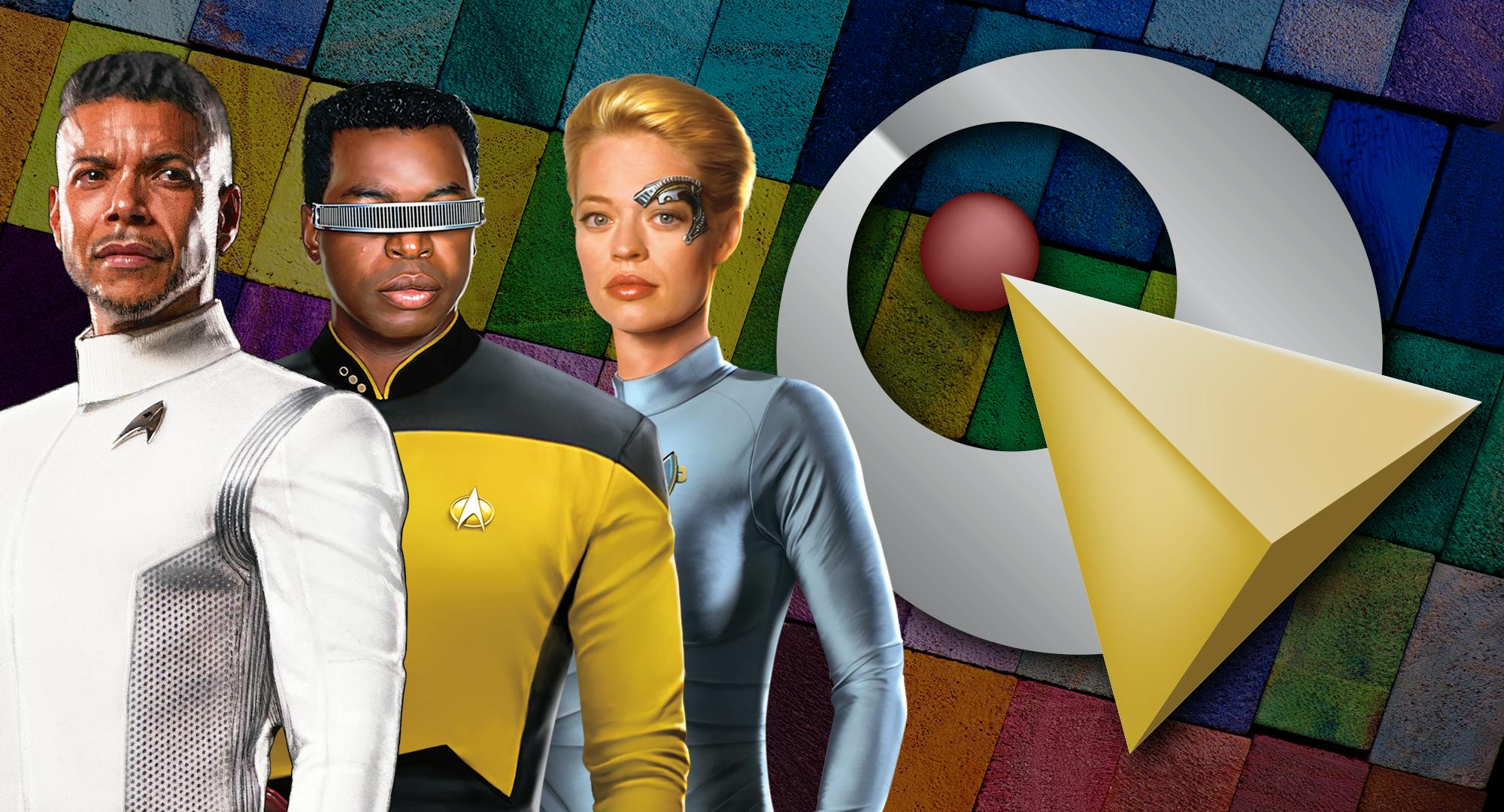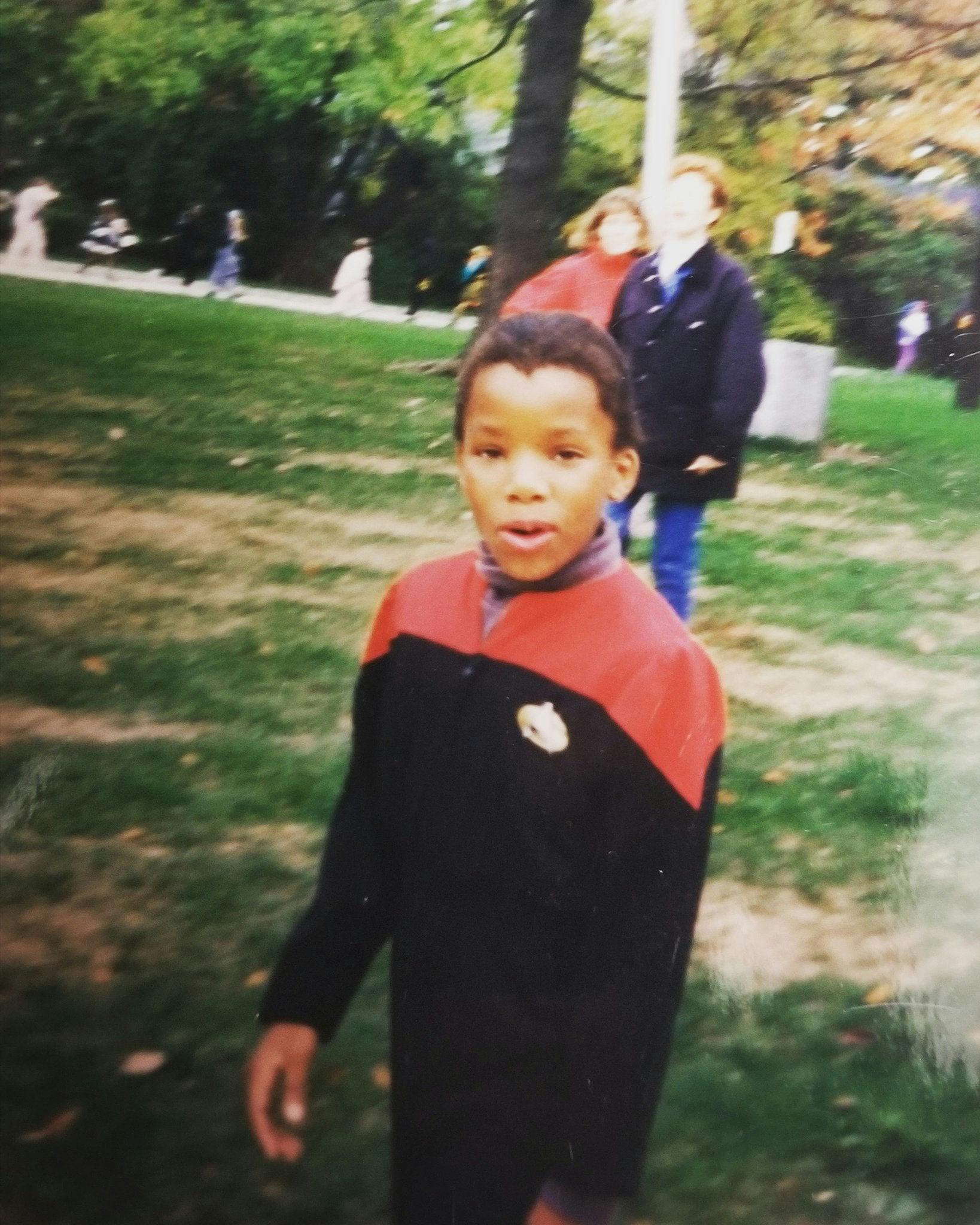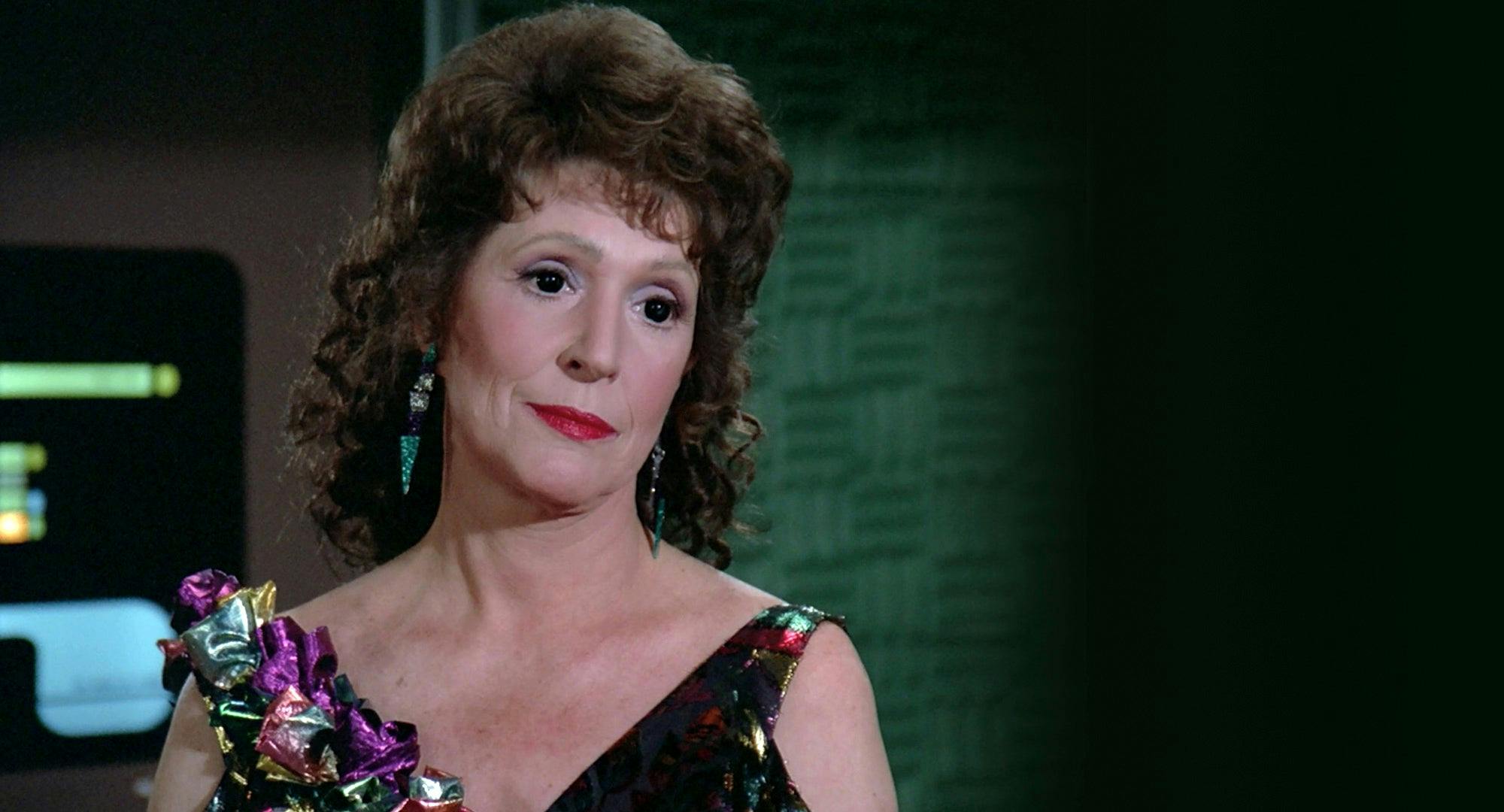Published Dec 30, 2019
StarTrek.com's Best of IDIC, 2019
Looking back at some of the fan authored pieces published this year that best represent Gene Roddenberry's vision of Infinite Diversities in Infinite Combinations.

StarTrek.com
When commissioning pieces for StarTrek.com, Gene Roddenberry’s infamous guiding creed remains ringing in the back of my mind at all times. Like each Star Trek series, StarTrek.com is a place that celebrates Infinite Diversities in Infinite Combinations— a phrase that means so much more now than perhaps even Roddenberry could have imagined. It goes beyond the bold steps he took of having a Black woman, an Asian man, and a Russian in positions of power and equality on the bridge of a ship during the height of the Civil Rights Movement, Vietnam, and the ensuing Cold War.
We now know that we must celebrate differences in race, culture, and ethnicity alongside gender, sexuality, socioeconomic class, physical ability, neuro-divergences and so much more. We also understand the concept of intersectionality. Simply, that means that no person can be defined by a single aspect of their diversity. To put that in Star Trek terms, it means taking into account (but not limiting to) Hugh Culber’s place in the LGBTQ community and within the Latino community… whatever that may look like 200-some years in the future.
I was a nerdy, sci-fi loving Black girl coming up in the 90s with no DVR and a VHS collection limited to Disney flicks and Sesame Street’s Follow That Bird. Books and comics helped to sate my science fiction obsession, but when it came to sitting in front of the TV for actual visuals I had three options where I could see myself represented in my favorite genre: M.A.N.T.I.S. on FOX, and Deep Space Nine on The WB. The latter lasted much longer than the former, leaving me, for a time, with a single option to see Black people both occupying space and leading in my favorite genre.

StarTrek.com
That experience forever shaped the way I see Star Trek. It’s always been a franchise where I simply expect to feel seen; so much to the point where I used to become actively confused and frustrated when other Black girls didn’t like it (apologies are owed, perhaps, to my very patient high school best friend). I expect to see women like Uhura and Michael Burnham. I’m not surprised when the concept of being a single, Black father raising a Black child is handled with grace. Whenever a new series is announced, live-action or animated, I never doubt that the ideas jousted over in the writers’ room will come from voices who represent infinite diversities in infinite combinations.
Each week on StarTrek.com, I strive to meet those expectations beyond the myopic view of my own life experience. If you are an Autistic, white cis-gendered man, I want you to have the expectation that you will feel represented here. If you are a gay Latino, or a neurotypical indigenous woman, I want you to feel the same way.
Welcome to the New StarTrek.com
That isn’t always easy to achieve, and we certainly haven’t succeeded perfectly as of yet. But the ongoing journey striving towards perfection has been —to channel Ensign Tilly for a moment— fucking cool. Through editing and reading your pieces, I’ve learned about the ways developments in AI tech have mirrored the plot of Discovery; the lens through which I’ve always seen the planet Risa has shifted, for the better; the best and worst days of my life were perfectly (almost preternaturally) synthesized in one piece that understood me better than I think I understand myself. It’s hard to simply not publish everything that shows up in our inbox, and I’ve so valued reading the myriad of ways Star Trek fans around the world view the universe that Gene Roddenberry created.
And so, as 2019 comes to a close, I wanted to share some of the always heartfelt, often hilarious, and certainly informative pieces written by diehard Star Trek fans that best represent what we have lovingly come to know as IDIC.
LLAP - Kendra James
StarTrek.com“In many ways, Geordi La Forge is the ideal fictionalization of a STEM professional with a disability. His vision impairment has never stopped him from fully participating in his career – and it certainly didn’t stop him from being promoted faster than any other character in any Star Trek series to date.
“Geordi began season one of The Next Generation as a Lieutenant Junior Grade helmsman, was promoted to Lieutenant in season two, and became a Lieutenant Commander and Chief Engineer of the Enterprise by season three. While Geordi is not the only character to have held three ranks, no other character in any Star Trek series has ascended the ranks so quickly… Burgstahler says that one of the most significant barriers to accessibility in STEM is the public perception that people with disabilities can’t contribute much in a STEM career.” - What Geordi La Forge Can Teach STEM About Accessibility, by Mike Straus

StarTrek.com
“The many facets of Lwaxana carry on in licensed Star Trek novels, where she’s a hero in the Dominion War’s Battle of Betazed. She’s also the hero of countless fanfiction portrayals where she takes on this exact role for the people who need her most: our horny, campy Space Aunt who always has the right wig for the occasion and is ready to accept us at our weirdest. She is a role model of flashy self-importance, liberated sexuality, a representative of her people, and a proponent of interspecies coupling. She’s not queer in the text, but she’s so closely modeled on the kind of Liz Taylor-esque, iconic drag-inspired grand dame that it’s almost impossible to separate her from that context. Space Aunt Lwaxana is the ultimate ally; the one who is always ready to accept who you are and fight for your right to be it.” - How Lwaxana Troi Became our Space Aunt, by Meg Elison
Ryan Estrada- My First Contact Connected to the Truth, by Ryan Estrada and Amy Rose
StarTrek.com“On future rewatches — with a slightly more experienced eye, a practiced habit of compartmentalization, and the understanding that the show and its choices were very much a product of the mid-nineties — I found that I adored Seven. She resisted simplicity in ways I found extremely narratively satisfying. I loved her for her sharpness and her arrogance, and for the surprising ways that those traits gave way, over time, to warmth and compassion. I would not have been nearly as forgiving of this character were it not for Jeri Ryan’s wonderfully nuanced and disciplined performance. I only wish I had recognized it sooner.” - Choosing the Sweater, by Ellen Hill
StarTrek.com“I’m almost done with TOS now. It’s gotten harder and harder for me to watch; I watched it too often when I was depressed, and now I’m afraid it’s become a trigger. But I will watch the last episode with the friend who’s been with me through it all. We will toast Kirk and Spock and space. I will toast myself — that I finished, even if I can’t remember. That all 79 episodes live somewhere in my body, even if I can’t feel them.” - When You Live With Memory Loss, Each Star Trek Rewatch Can Feel Like the First, by Jamie Beckenstein
StarTrek.com“The Star Trek fandom, especially on Twitter, are a very important part of my recovery. My friends and family continue to support me as I recover from my addiction; and whether it’s virtually or face-to-face, I know that they have my back. And I certainly have theirs.
“It hasn’t always been easy. I’ve made mistakes and I’ll continue to do so. We all do. After all, as Captain Kirk once pointed out, we’re all human. Today, I’m more at ease with those mistakes and flaws. After a year of therapy, I’ve learned to embrace my enemy within and love it as part of who I am.” - Star Trek Saved My Life, Literally, by Ryan Thomas Riddle
StarTrek.com“So much of Star Trek — and all good science fiction — can be used to draw parallels to or illuminate facets of the real world, and the show doesn’t disappoint even with something as specific as Yom Kippur. Two episodes in particular, one which focuses on an anti-hero’s quest for repentance and another which focuses on an anti-hero’s quest for forgiveness, can help us understand the right way to seek atonement and the wrong way to seek atonement.
“...These episodes hammer home the lesson that forgiveness cannot begin when there is no repentance in sight ... Recognizing that what he had done was destructive, Jetrel instead spent the end of his life seeking to undo at least some of the horrors he had unleashed. He is an example of looking at and owning the worst parts of oneself, and then trying to do something about it. Dukat, on the other hand, is an example of what happens when someone can't even admit to having done anything wrong. The lesson of Yom Kippur is that what matters is the repentance.” - Seeking Repentance in Star Trek, by Chanda Prescod-Weinstein
StarTrek.com“As a queer Star Trek fan, when I realized that Vulcan names might be following and breaking the gendered “rules” for as many reasons as there are Vulcans, I was filled with joy at the wonderful ideals that this would indicate about Vulcan society. Here is a planet and a culture full of fascinating, nuanced characters living all sorts of lives while exemplifying a whole spectrum of gender expressions – just like me and my human friends, here and now. I think of my queer community and the people I know and love, and I see us making the same sort of decisions about how we present ourselves as Vulcans might be making with their names. How do we want people to see us? How do we want the world to know and remember us? Do we want to throw our lot in with any one gendered convention, or multiple conventions, or none of them?” - The Potential for Queerness in Vulcan Culture, by Julia Peterson
StarTrek.com“For the most part, my love of all things ‘60s Star Trek tended to reinforce the idea that churches — or things that claimed to be houses of God — were likely deceitful places. If you didn’t know anything about what Captain Kirk’s job really was on TOS, you might be shocked to discover that in several episodes he’s basically a false-god-unmasker.
“The sympathetic portrait of Sybok helped prepare me for these kinds of emotional extremes in my life...For me, this acceptance of extremes — of not making Sybok a true villain — is the subtle brilliance of this film; the notion that family can be religion, and faith can be friendship.” - How 'The Final Frontier' Made Me a Nicer Kid (and Better Person), by Ryan Britt
StarTrek.com“The severity of my OCD frequently fluctuates, creating new roadblocks and sending me scrambling to adapt like a Borg drone under attack…. Unlike Captain Picard, who wisely sought out Counselor Troi’s guidance after his ordeal with Gul Madred in The Next Generation’s “Chain of Command, Part II,” I was foolishly reluctant to find professional treatment. Coupled with my anxiety, my OCD ran rampant and asserted control over my life.
“I saw myself in Reginald Barclay’s fear of transporters in The Next Generation’s “Realm of Fear,” and in the claustrophobia that Elim Garak grappled with in DS9’s “By Inferno’s Light.” Connecting with the way those characters confronted their phobias empowered me to finally see a therapist and begin treatment for my OCD. Speaking with a medical professional and taking medication for my condition energized me with enough confidence to finally search for ways to express my passion for Star Trek and discuss the franchise with other fans.” - Engaging My Collective, by Jay Stobie
StarTrek.com“Re-watching “Captain’s Holiday,” I was reminded of my experience as a closeted person in college. My friends watched me read books and write poetry and listen to Belle and Sebastian, and they figured that what I needed was a girlfriend, so they signed me up for OKCupid. I was … not comfortable with this. Being forced to dabble with the idea of sex as someone who was, then, uncomfortable with their sexuality and gender identity felt like learning, to my horror, that my friends perceived me as straight! And it kept happening for years! I was really buttoned up about it, the way Picard is in the episode, constantly surrounded with the fantasies of others, the fantasies other people held for me, without an ideal outlet for any of it.
"Eventually, like Picard finding cave to dig a hole in, I found the outlet I needed, and was able to open myself up to the idea of being someone capable of desire and being desired. Risa functions as a door to that possibility for these characters, but it’s ultimately up to them to step through it. That most of them do — and in ways that speak so truly to human nature — is one of the small, delightful surprises of the series.” A Trip to the Pleasure Planet, by Colette Arrand and Daniel Mallory OrtbergStarTrek.com“Yes, the marginalized group in Star Trek IV is whales, and they’re not so much marginalized as they are completely extinct. Yes, I get that that’s a very weird parallel to draw, and that no one really wants to be compared to a whale (although, in all fairness, George and Gracie are Very Good Whales). But the focus of The Voyage Home isn’t actually George and Gracie themselves, but rather, what they represent: hope for the future. And while I can only speak for myself, lifting up the marginalized as a path toward hope is a parallel I can get behind.” - The Biggest Lesson From 'Star Trek IV: The Voyage Home' Isn't Talked About Enough, by Lauren Thoman
StarTrek.com“Trek’s impact on Huey ran deep, but the activist did not truly grasp how much the franchise influenced his worldview until after he began his career in politics. “Star Trek grounded me in progressive values and allowed me to see that the world could be a better place,” says Huey. “I didn’t know this for a long time, but I grew up with a utopian future that didn’t just seem aspirational, but for a child, possible.” Huey believes that a crucial lesson he digested actually stemmed from The Next Generation’s creative staff and the idea of the Prime Directive. “They really examined what the idea of not judging and not interfering with other cultures means, moving away from an imperialist idea that we will export our values, but instead embrace differences and learn from others.” - Asher Huey Makes a Living Putting the Needs of the Many Ahead of Everything Else, by Jay Stobie (with Asher Huey)
StarTrek.com“Pike hails from an era that may seem somewhat removed from more modern takes on the Star Trek franchise, but his character remains an important symbol of the power inherent in it. If Trek is an optimistic reflection of our best selves as a society, then Pike’s character offers a similar take on what it means to be human. Flawed, to be sure, but decent and brave –the kind of everyday hero we could all hope to be in real life.
"...Goodness, after all, is not a character trait. It isn’t something you are; it’s something you do. It’s a choice, and it’s one that must be made repeatedly. That’s what makes it hard. It takes real work to be a decent person, and it’s an effort to choose to do the right thing simply for its own sake.” - Captain Pike Represents the Future Discovery Needs, by Elisabeth Sherman
StarTrek.com“Looking back, I knew I was different, but couldn't articulate how: it would take decades to process how my queerness, my Asianness, and my curiosity for STEM would define me, but also Other-ed me. The idea of the "Asian nerd" is a crushing stereotype because it takes a strength and curdles it into a weakness. What drew praise from adults drew venom from other children. I had to navigate these identities — queer, nerdy, Asian — sometimes individually, and eventually in concert with one another. But I always found that Star Trek has nourished each identity, and helped bring them together.
"...Imagining myself on a starship was easy; the crew of the Enterprise looked more like my neighborhood in Toronto than most television shows, a mosaic of men and women from countries around the world. The additions of Rosalind Chao and Patti Yasutake as recurring cast members in the fourth season of TNG thrilled me: here were women who looked like my family members making important contributions to the Star Trek universe.” - Through 'Star Trek,' I Found Pride in Being a Queer Man in STEM, by Jaime Woo















